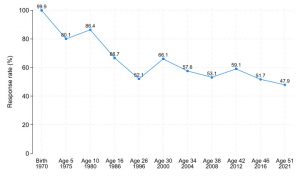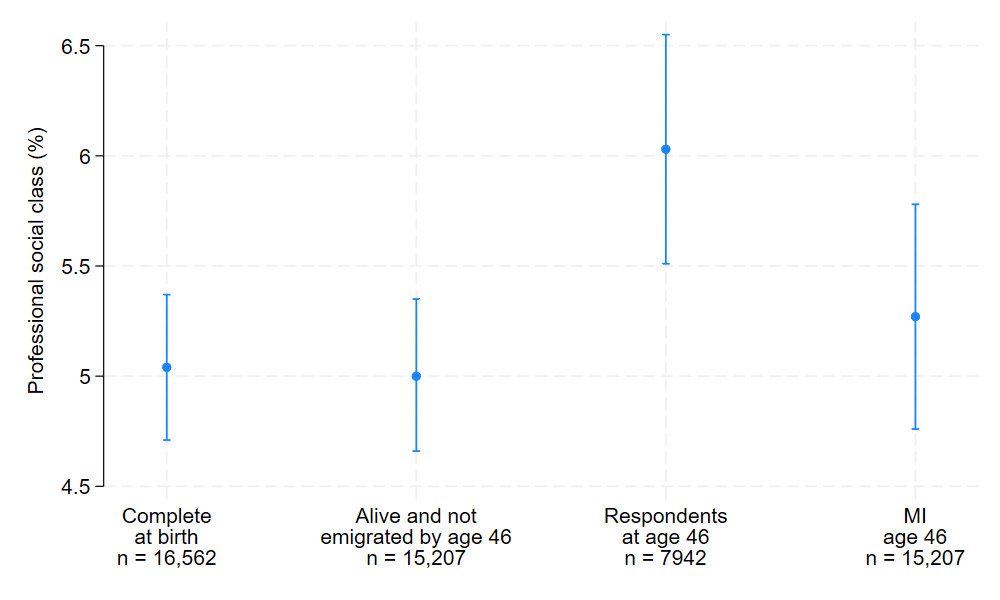BCS70 response and missingness
BCS70 response
The table below presents statistics about response in BCS70 at every major sweep from birth.
Of the 16,589 cohort members who participated in the first sweep, 2,763 (16.7%) have participated in all 11 major sweeps.
Of all 18,038 cohort members, 11,300 (62.6%) have taken part in at least half the sweeps (ie six or more sweeps).
Table: Participation in BCS70 from birth to 51 years
|
Total cohort |
Dead |
Emigrants |
Eligible sample |
Participants |
(% of eligible sample) |
| Birth – 1970 |
16,606 |
0 |
0 |
16,606 |
16,589 |
99.9 |
| Age 5 – 1975 |
16,959a |
567 |
0 |
16,392 |
13,135 |
80.1 |
| Age 10 – 1980 |
17,799a |
589 |
0 |
17,210 |
14,870 |
86.4 |
| Age 16 – 1986 |
18,038a |
622 |
0 |
17,416 |
11,615 |
66.7 |
| Age 26 – 1996 |
18,038 |
716 |
35 |
17,287 |
9,003 |
52.1 |
| Age 30 – 2000 |
18,038 |
766 |
235 |
17,037 |
11,261 |
66.1 |
| Age 34 – 2004 |
18,038 |
819 |
432 |
16,787 |
9,665 |
57.6 |
| Age 38 – 2008 |
18,038 |
881 |
456 |
16,701 |
8,874 |
53.1 |
| Age 42 – 2012 |
18,038 |
965 |
433 |
16,640 |
9,841 |
59.1 |
| Age 46 – 2016 |
18,038 |
985 |
466 |
16,587 |
8,581 |
51.7 |
| Age 51 – 2021 |
18,038 |
1,047 |
242 |
16,749 |
8,016 |
47.9 |
a The original sample was supplemented by migrants born in 1970.
Figure 1: BCS70 response (as % of eligible sample) over time

Missingness in BCS70
BCS70 variables
We have used a systematic data-driven approach to identify variables that are important predictors of non-response at each BCS70 sweep between age 5 and age 46. Future work will extend this analysis to include non-response at the age 51 sweep.
A list of these variables is provided in the appendix of the Handling missing data in the CLS cohort studies user guide.
These variables can then be considered for inclusion in analyses – for example as auxiliary variable when using multiple imputation – in order to maximise the plausibility of the missing at random (MAR) assumption.
Read more about the process in the preprint: A data-driven approach to address missing data in the 1970 British birth cohort.
Example: restoring the composition of BCS70 at age 46
We have been able to restore the composition of the BCS70 sample at age 46 to be more representative of the study’s target population. We did this by including predictors of non-response at age 46 as auxiliary variables in multiple imputation analyses.
For example, we were able to replicate:
- the original distribution of paternal social class observed at the birth survey
- the distribution of cognitive ability at age five
Figure 2: Social class of mother’s husband at birth before and after adjustment for missing data

The imputation phase of this analysis included predictors of non-response at age 46 and social class at birth only for cohort members that participated at age 46.
Figure 3: Mean cognitive ability at age 5 before and after adjustment for missing data

The imputation phase of this analysis included predictors of non-response at age 46 and cognitive ability at age 5 only for cohort members that participated at age 46.








